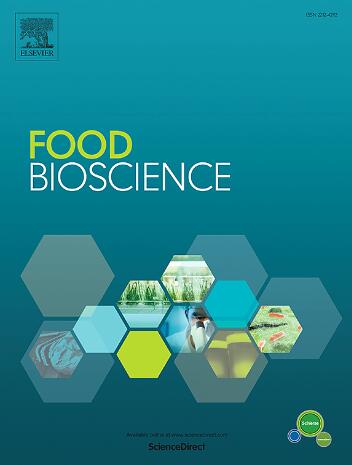Comparative antimicrobial activity of ethanol and aqueous extracts of Ziziphus lotus against bacteria and fungi
IF 4.8
1区 农林科学
Q1 FOOD SCIENCE & TECHNOLOGY
引用次数: 0
Abstract
Background
Ziziphus lotus (L.) is a medicinal plant known by its potential antioxidant activities. Its fruits, leaves, and roots have been employed to treat various deseases including inflammation, gastrointestinal intoxication, anxiety, diabetes, and tuberculosis infection.
Objective
This study investigates the antibacterial and antifungal activities of aqueous and ethanol extracts from different parts of Ziziphus lotus (roots, stems, leaves, flowers, and fruits) against a range of bacterial and fungal strains. Eight bacterial strains (Staphylococcus aureus, Micrococcus luteus, Listeria monocytogenes, Enterococcus faecalis, Bacillus cereus, Escherichia coli, Pseudomonas aeruginosa, and Salmonella typhimurium) and five fungal strains (Candida albicans, Candida krusei, Candida neoformans, Aspergillus brasiliensis, and Aspergillus fumigatus) were tested.
Results
The ethanol fruit extract exhibited the most potent antibacterial activity, with a minimum inhibitory concentration (MIC) of 0.012 mg/mL against Staphylococcus aureus and strongest antibacterial activity against Bacillus cereus. Leaf and flower extracts showed activity against Enterococcus faecalis. Aqueous extracts demonstrated moderate antibacterial effects, with the leaf extract showing an MIC of 1.23 mg/mL against Staphylococcus. aureus, and the flower extract being effective against Listeria monocytogenes and B. cereus (MIC of 18.75 mg/mL). For antifungal activity, the ethanol fruit extract exhibited the strongest effects, with a MIC of 0.012 mg/mL against C. albicans, and significant activity against C. krusei and A. brasiliensis (0.11 mg/mL). The aqueous leaf extract showed the best antifungal activity, with an MIC of 1.23 mg/mL against C. albicans, and notable effects against Aspergillus spp. (11.11 mg/mL).
Conclusion
These results confirm the traditional use of Ziziphus lotus in treating bacterial and fungal infections, demonstrating the activity of its extracts against a wide range of pathogens.
荷花乙醇和水提物对细菌和真菌的抑菌活性比较
背景:酸枣是一种具有潜在抗氧化活性的药用植物。它的果实、叶子和根被用来治疗各种疾病,包括炎症、胃肠道中毒、焦虑、糖尿病和肺结核感染。目的研究酸枣不同部位(根、茎、叶、花和果实)的水提物和乙醇提物对多种细菌和真菌的抑菌活性。共检测了8株细菌(金黄色葡萄球菌、黄体微球菌、单核增生李斯特菌、粪肠球菌、蜡样芽孢杆菌、大肠杆菌、铜绿假单胞菌、鼠伤寒沙门菌)和5株真菌(白色念珠菌、克氏念珠菌、新生念珠菌、巴西曲霉、烟曲霉)。结果果实乙醇提取物对金黄色葡萄球菌的最低抑制浓度(MIC)为0.012 mg/mL,对蜡样芽孢杆菌的抑菌活性最强。叶提取物和花提取物对粪肠球菌有一定的抑制作用。水提物表现出适度的抗菌作用,叶提物对葡萄球菌的MIC为1.23 mg/mL。花提取物对单核增生李斯特菌和蜡样芽孢杆菌均有较好的抑菌效果(MIC为18.75 mg/mL)。在抗真菌活性方面,果实乙醇提取物的抗真菌活性最强,对白色念珠菌的MIC值为0.012 mg/mL,对克鲁西念珠菌和巴西念珠菌的MIC值为0.11 mg/mL。叶水提物对白色念珠菌的MIC为1.23 mg/mL,对曲霉的MIC为11.11 mg/mL,抑菌效果最好。结论荷叶提取物具有抗多种病原菌的活性,证实了荷叶提取物对细菌和真菌感染的治疗作用。
本文章由计算机程序翻译,如有差异,请以英文原文为准。
求助全文
约1分钟内获得全文
求助全文
来源期刊

Food Bioscience
Biochemistry, Genetics and Molecular Biology-Biochemistry
CiteScore
6.40
自引率
5.80%
发文量
671
审稿时长
27 days
期刊介绍:
Food Bioscience is a peer-reviewed journal that aims to provide a forum for recent developments in the field of bio-related food research. The journal focuses on both fundamental and applied research worldwide, with special attention to ethnic and cultural aspects of food bioresearch.
 求助内容:
求助内容: 应助结果提醒方式:
应助结果提醒方式:


